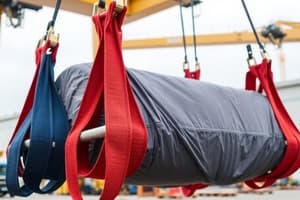Podcast
Questions and Answers
Before attempting to lift any material you should...
Before attempting to lift any material you should...
- Look for any protruding nails, wires, or sharp edges (correct)
- Check the weather
- Ask for help
- All of the above
Before attempting to lower an overhead load you should...
Before attempting to lower an overhead load you should...
- Use a pulley
- Size up the load (correct)
- Estimate the weight
- Call for assistance
What is the proper procedure to lift objects?
What is the proper procedure to lift objects?
Lift with your legs, keep your back straight, and keep your head up
When stacking bags of material that are the same width, step back and cross key the bags...
When stacking bags of material that are the same width, step back and cross key the bags...
Never stack or store materials...
Never stack or store materials...
The knot shown in the figure above is a...
The knot shown in the figure above is a...
One common way to tie a clove hitch is to use two...
One common way to tie a clove hitch is to use two...
When moving a material cart on an inclined or declined surface, be sure the...
When moving a material cart on an inclined or declined surface, be sure the...
To transport a bottle of compressed gas, use a...
To transport a bottle of compressed gas, use a...
What device may have a rotating table surface and/or spikes on the table surface for a better grip?
What device may have a rotating table surface and/or spikes on the table surface for a better grip?
To work with motorized material-handling equipment, a worker must...
To work with motorized material-handling equipment, a worker must...
How is the fall zone for a forklift operation best defined?
How is the fall zone for a forklift operation best defined?
To prevent a tipover when driving a rough terrain forklift, keep the load...
To prevent a tipover when driving a rough terrain forklift, keep the load...
When using hand signals, always...
When using hand signals, always...
The forklift hand signal for 'dog everything' means...
The forklift hand signal for 'dog everything' means...
Flashcards
Before lifting material...
Before lifting material...
Inspect for hazards like nails, wires, or sharp edges.
Before lowering an overhead load...
Before lowering an overhead load...
Assess the weight and stability of the load.
Proper lifting procedure
Proper lifting procedure
Bend your legs, keep your back straight, and look up.
Keying stacked bags
Keying stacked bags
Signup and view all the flashcards
Where NOT to stack materials
Where NOT to stack materials
Signup and view all the flashcards
Clove hitch
Clove hitch
Signup and view all the flashcards
How to tie a clove hitch
How to tie a clove hitch
Signup and view all the flashcards
Material cart on an incline
Material cart on an incline
Signup and view all the flashcards
Transporting gas cylinders
Transporting gas cylinders
Signup and view all the flashcards
Roller skid features
Roller skid features
Signup and view all the flashcards
Operating motorized equipment
Operating motorized equipment
Signup and view all the flashcards
Forklift fall zone
Forklift fall zone
Signup and view all the flashcards
Forklift load position
Forklift load position
Signup and view all the flashcards
Hand signal key
Hand signal key
Signup and view all the flashcards
Forklift 'dog everything' signal
Forklift 'dog everything' signal
Signup and view all the flashcards
Study Notes
Lifting and Moving Materials
- Before lifting any material, inspect for sharp edges, nails, or wires.
- Assess the weight and stability of overhead loads before lowering them.
- Proper lifting technique includes using legs for strength, keeping back straight, and head up to prevent injury.
Stacking and Storage Protocols
- Stack bags of the same width by crossing them every ten bags high for stability.
- Materials should never be stored or stacked on scaffolding to avoid accidents.
Knot Tying and Material Handling
- A clove hitch is used for securing items and can be tied with two half hitches.
- When transporting materials on slopes, ensure the load remains within the labeled weight limit.
Equipment and Transportation
- Use a cylinder cart for transporting compressed gas bottles.
- Roller skids may feature a rotating table surface or spikes for improved grip.
Operator Training and Safety
- Workers must be trained, certified, and authorized to operate motorized material-handling equipment.
- The fall zone of forklift operations includes any area where lifted materials could fall, emphasizing the need for caution.
Forklift Safety Measures
- Maintain a low load to prevent tipovers when driving a rough terrain forklift.
- Always use hand signals and maintain eye contact with the operator for safe communication.
- The hand signal for "dog everything" instructs operators to pause operations, enhancing safety awareness.
Studying That Suits You
Use AI to generate personalized quizzes and flashcards to suit your learning preferences.




